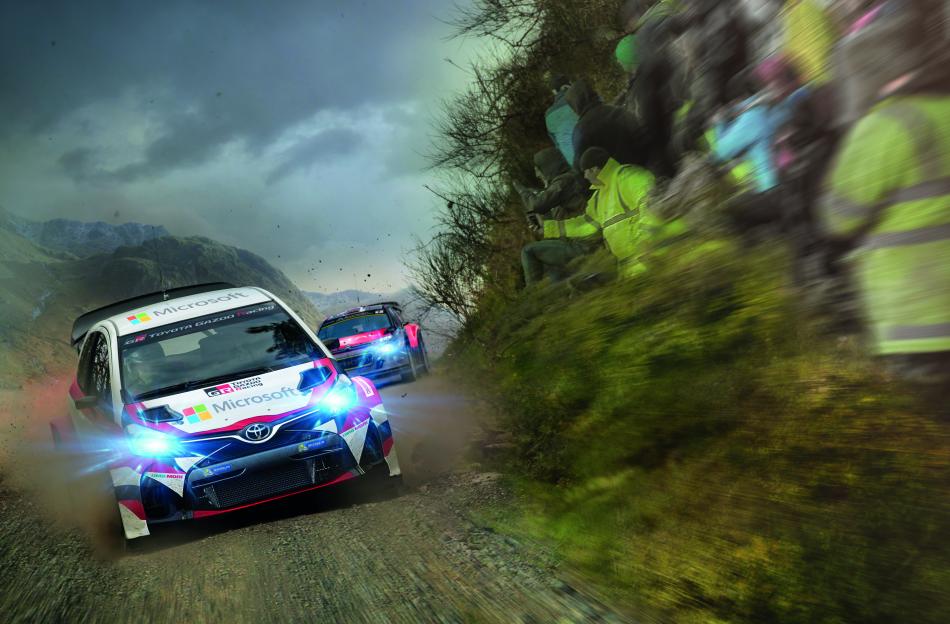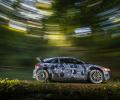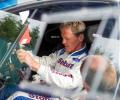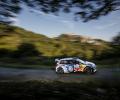AUTO #17 - Living the Dream
The most exciting cars to grace the World Rally Championship since the days of Group B will arrive on stage in 2017, only this new breed should be among the safest too

Finnish summers are about long days and fast cars. Today, the day couldn’t get much longer. The car certainly couldn’t get much faster. And 12-year-old Jukka’s beaming smile has just proved FIA president Jean Todt right.
Skipping double maths or extended English, Jukka and his father have come to this road, just outside their hometown of Jämsä. The road is the same one they use to drive to school every day. Not today.
Today, it’s being borrowed by Kris Meeke, Paul Nagle and the Citroën WRC team. And it’s not being driven. It’s being flown. Trouble is, it’s lunchtime and Jukka’s father wants to get home while the road’s not being used. Jukka’s not for moving, arms locked around a lamppost in protest.
His father raises his eyebrows.
“He dreams for this car,” he smiles in his son’s direction, while trying to prise fingers open and his son out of his dream. It’s not hard to see why Jukka would want to skip lunch. This is a typically Finnish road, full of blind crests, beautiful cambers and deliciously sweeping corners.
Time after time, Meeke has sent Citroën’s C3 WRC 2017 car ballistic with longitude and latitude, landing in the middle of the next corner on one wheel with three-quarter lock.
Even trained eyes blink.
To Jukka, it’s another world.
It’s a world Jean Todt wanted to create. “When I look at the current World Rally Cars,” Todt says, “I don’t see people dreaming about them. When the new cars come, I want people to dream. I want them to dream like they did when they saw Group B cars. “These were the cars for the bedroom walls.”
That there’s one on such a wall in Jämsä bears testament to Todt’s aspirations for the 2017 World Rally Championship. These cars are that good.
For too long it’s been too easy to talk of the current cars looking and sounding the same. That’s all about to change. The World Rally Championship is stepping up a gear. Possibly two.
WHY CHANGE?
Much of this was instigated from the very top of the governing body, with Todt feeling there was an absence of drama in the current cars. The last time the Frenchman had spent any time in rallying, scoops, wings, width and wonder had been de rigeur.
Quite simply, the sport needed more of what he’d helped deliver with Peugeot’s stunning 205 T16. And, while the current car’s silhouette was getting an overhaul, why not give them a bit more grunt just to help them shift sticky tyres on bone-dry asphalt? If it’s drama you’re after, a squirming rally car tagging black lines usually ticks the box.
In addition to the exterior overhaul and the hike in power, the change of technical regulations offered an opportunity for further work on crew safety aboard the all-new 2017 World Rally Car.
The moment was right for evolution, but instead the FIA’s gone even further. We’re talking about a revolution…
WHAT’S DIFFERENT?
Typically, it’s the increase in power that catches the eye. But moving from just over 300 to almost 400bhp has not been the work of a moment. Citroën’s engine manager Patrice Davesne admits plenty of midnight oil has been burned in Versailles – even with a wealth of experience from using a similar engine in the team’s vastly successful World Touring Car Championship campaign.
Davesne says: “The difference is the inlet turbo restrictor. It was 33mm and now it’s 36mm, which means about 20 per cent more air flow. Because of this we need to change the turbo charger because the compressor side is not large enough, so we develop a new one to adapt to this new flow.”
Citroën hasn’t stopped at a new restrictor and turbo, it’s gone way further and built a whole new motor – including fundamental changes to parts that have remained the same since the Xsara WRC was introduced 15 years ago.
“We develop a fully new engine,” says Davesne. “We decided to change the bore, it was 82mm since the beginning of our time in WRC and now we decide to increase the bore diameter to 84mm, the limit allowed by the FIA.”
The numbers are interesting, but the key question is about how these changes will affect the car. There can’t be any more torque due to a limit of 2.5-bar boost pressure on the turbo. But there can be more power.
“The change of the new engine is only power,” says Davesne. “With the new restrictor, we have more power at higher revs. Concerning the driveability, the feeling of the drivers is that it depends on the road: if the stage is quick, like in Finland, they said it’s an evolution not a revolution. On the tricky roads, the increase of the power creates greater acceleration and the feeling of the drivers is, ‘Wow, it’s another world!’”
POWER TO THE PEOPLE
Rarely, if ever, has there been such excitement about the start of a new WRC season and the continued comparisons with Group B have only served to further that enthusiasm.
“These cars are going to be incredible,” says Tommi Mäkinen. And he should know. Before Mäkinen signed up as Toyota Gazoo Racing team principal, he won four FIA World Rally Championship drivers’ titles. Oh, and he’s done a whole heap of testing in the all-new Yaris WRC – the car that marks the Japanese car giant’s first return to the series since 1999.
“The car is fantastic to drive,” he adds, “with so much power and so many changes in the aerodynamics. These cars will really bring back the people to our sport.”
Visually, it’s impossible to ignore the step with the 2017 cars. They’re wider, longer, come with a deep front and rear splitter and a bigger, even bolder wing that sits higher above the roofline and looks down on wider arches than in recent years.
In short, the 2017 World Rally Car is simply gorgeous. “It’s not hard to see where the comparison comes with Group B cars,” smiles M-Sport boss Malcolm Wilson. “I’ve driven both, and I can tell you, these current cars are on another level again.
They’re sensational.”
Even the withdrawal of Volkswagen from the sport (for entirely unrelated reasons) has not dented spirits. World champion and now former VW driver Sébastien Ogier is just as excited as everyone else.
“They’re going to be special cars to drive,” he says. “It’s an exciting future in 2017 with these cars. The speed is fantastic, not so much from the torque from the engine, but the power and the way the aero is working. I’m really looking forward to next season and I think it will also be nice for the fans as well.
“The cars look so aggressive, you can see this even from the pictures and the videos on social media. We have all been watching them and we are all looking forward to seeing them on the stage.”
As well as the visuals, one of the key changes comes in the suspension and transmission set-up.
Matthew Wilson has tested M-Sport’s all-new Ford Fiesta RS WRC extensively and he says the new chassis is a huge step forward.
“Last year we put the new engine into one of this year’s chassis,” says Matthew. “Being brutally honest, the current car coped with it, but it felt horrible. The new chassis with the suspension and the active centre differential have transformed it. Everything just feels right, the power and the car work beautifully together. The centre diff is something we last had in 2010 and it gives you a real chance to tune the car to the road – again, this will make the cars even quicker.”
SAFETY IN NUMBERS
As well as more power, the FIA and the Global Institute for Motor Sport Safety have worked tirelessly to improve safety aboard the all-new World Rally Cars. The teams have already completed unprecedented side-impact crash testing and have put the data gathered to the best use possible.
The added girth in next year’s cars isn’t there just to make them look meaner, it’s there to add strength.
That added width is packed with safety features. M-Sport’s Malcolm Wilson explains: “The current situation is that we have the crash protection already; the energy-absorbing foam on the inside of the door panel and around the area close to where the seats are, and a carbon fibre door panel, which has got some honeycomb aluminium to give some strength. The new regulations for 2017 stipulate the foam must be increased from 200mm to 240mm in depth, which provides a 20 per cent increase in energy management and side-impact protection.”
Side-impact protection has been at the forefront of every driver, co-driver and car designer’s mind since Michael Park’s death while co-driving Markko Märtin in a Peugeot 307 WRC in 2005.
In addition to the energy-absorbing foam, sills have been strengthened and the crew even better catered for aboard.
Wilson says: “Sill protection is another big aspect, because those are the accidents that we as the manufacturers, and the drivers and co-drivers, fear: the side impact into a post or a tree.
“We actually introduced a sill beam in our cars in 2006, but that has now become compulsory. Over the years we’ve extended and extended it because we’ve been involved in accidents where you’ve had an impact in front of the seat, and, of course, you need as much sill protection there. That’s now a regulation for next year.
“There’s been a big step in roll cage design, to the point now where it is the main structure of the car that picks up on all the suspension points. This means, in an accident, you’re transferring the load throughout the entire bodyshell. But that’s just part of it: the seat is now like a safety shell, designed so it moves into the car [in a crash].
“Additionally in the seat area, we will reduce the gap between the crash helmet in relation to the proximity to the high-strength area of the seat. So what we will end up with next year is a 50mm gap either side of the crash helmet. This, coupled with the HANS device, will mean there is less head movement than previously possible and obviously less chance of any injury.”
SAFETY FURTHER
FIA rally director Jarmo Mahonen has overseen all this safety work and he’s delighted with the progress made ahead of what’s going to be the start of a new chapter in the World Rally Championship.
“We know the cars are going to be quicker,” says Mahonen, “and we know the corner speeds will be higher – it’s these things that are going to make the WRC even more exciting than ever. But at the same time we are working to make the sport safer than it’s ever been.”
Looking back to Group B has a tendency to have folk reaching for their rose-tinted spectacles. Rallying’s most dramatic four years were not all about power and glory. There was a lot of tragedy associated with cars that were shockingly quick and staggeringly dangerous.
Lessons have been learned. And not just in the cars. “You know how much work we’ve put into the car,” says Mahonen, “but what we’re doing now is working with the organisers and rallies themselves. We’re looking at the itineraries the events are putting together, then we have Michèle Mouton as our safety delegate and she’s looking at the roads from a driver’s view. If she’s not happy with what she finds – if she feels the fans are going to be in the wrong place – we change them. Our aim is to make this sport as safe as it can be.”
Globally fans are counting the minutes until Rallye Monte-Carlo in January. Fervour’s nothing new at the start of a new season, but this kind of borderline fanaticism is saved for the dawn of a new era.
Like now.
The road is ready. The heroes of this new world order will break cover any time soon. After which they’ll be appearing on stages – and bedroom walls – soon after.
Apart from in Jämsä. Jukka’s got that one covered.
Click here to read the full AUTO #17 issue online.

 Facebook
Facebook Twitter
Twitter






